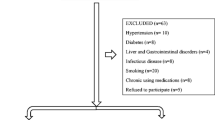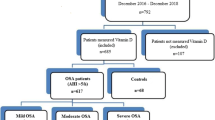Abstract
Purpose
This study was aimed to assess potential correlations between periodic leg movement (PLM) index, hepcidin levels, and iron status in patients with obstructive sleep apnea syndrome (OSAS).
Methods
Forty-four newly diagnosed OSAS patients and 49 non-apneic controls were enrolled in this study. All patients underwent polysomnographic evaluation. The hepcidin, iron, ferritin, total iron binding capacity, and C-reactive protein levels were measured.
Results
The mean age was 47.4 ± 7.2 years (18–68) in the OSAS group and 44.9 ± 11.1 years (23–65) in the control group. There were no differences in age, gender, and smoking between OSAS patients and controls. Mean apnea–hypopnea index (AHI) was 25.1 events/h. Mean serum hepcidin levels were significantly higher in OSAS subjects (725.9 ng/ml) than in control subjects (646.0 ng/ml) (p < 0.001). Serum iron levels were significantly lower in the OSAS and PLM disorder groups than in control subjects (p < 0.001). Serum hepcidin levels were significantly correlated with AHI (r = 0.453) and PLM index (r = 0.114). Serum iron levels were significantly negatively correlated with AHI (r = −0.169) and PLM index (r = −0.180).
Conclusions
In our study, the level of hepcidin was increased in patients with OSAS. Our study indicates that levels of hepcidin correlate with the AHI and PLM index severity of OSAS.





Similar content being viewed by others
References
Chervin RD (2001) Periodic leg movements and sleepiness in patients evaluated for sleep-disordered breathing. Am J Respir Crit Care Med 164:1454–1458
Al-Alawi A, Mulgrew A, Tench E, Ryan CF (2006) Prevalence, risk factors and impact on daytime sleepiness and hypertension of periodic leg movements with arousals in patients with obstructive sleep apnea. J Clin Sleep Med 2:281–287
Aurora RN, Kristo DA, Bista SR, Rowley JA, Zak RS, Casey KR, Lamm CI, Tracy SL, Rosenberg RS, American Academy of Sleep Medicine (2012) The treatment of restless legs syndrome and periodic limb movement disorder in adults–an update for 2012: practice parameters with an evidence-based systematic review and meta-analyses: an American Academy of Sleep Medicine Clinical Practice Guideline. Sleep 35:1039–1062
Grim K, Lee B, Sung AY, Kotagal S (2013) Treatment of childhood-onset restless legs syndrome and periodic limb movement disorder using intravenous iron sucrose. Sleep Med 14:1100–1104
Lin CH, Wu VC, Li WY, Sy HN, Wu SL, Chang CC, Chiu PF, Lion HH, Lin CY, Chang HW, Lin SY, Wu KD, Chen YM, Wu RM (2014) Restless legs syndrome in end-stage renal disease: a multicenter study in Taiwan. Eur J Neurol 21:492–498
Manconi M, Govoni V, De Vito A, Economou NT, Cesnik E, Casetta I, Mollica G, Ferini-Strambi L, Granieri E (2004) Restless legs syndrome and pregnancy. Neurology 63:1065
Ekbom KA (1969) Restless legs syndrome. Neurology 10:868–873
Allen RP, Auerbach S, Bahrain H, Auerbach M, Earley CJ (2013) The prevalence and impact of restless legs syndrome on patients with iron deficiency anemia. Am J Hematol 88:261–264
Lee CS, Lee SD, Kang SH, Park HY, Yoon IY (2014) Comparison of the efficacies of oral iron and pramipexole for the treatment of restless legs syndrome patients with low serum ferritin. Eur J Neurol 21:260–266
Weinstein DA, Roy CN, Fleming MD, Loda MF, Wolfsdorf JI, Andrews NC (2002) Inappropriate expression of hepcidin is associated with iron refractory anemia: implications for the anemia of chronic disease. Blood 100:3776–8371
Nicolas G, Chauvet C, Viatte L, Danan JL, Bigard X, Devaux I, Beaumont C, Kahn A, Vaulont S (2002) The gene encoding the iron regulatory peptide hepcidin is regulated by anemia, hypoxia, and inflammation. J Clin Invest 110:1037–1044
Nemeth E, Valore EV, Territo M, Schiller G, Lichtenstein A, Ganz T (2003) Hepcidin, a putative mediator of anemia of inflammation, is a type II acute-phase protein. Blood 101:2461–2463
Bergamaschi G, Villani L (2009) Serum hepcidin: a novel diagnostic tool in disorders of iron metabolism. Haematologica 94:1631–1633
Ganz T, Olbina G, Girelli D, Nemeth E, Westerman M (2008) Immunoassay for human serum hepcidin. Blood 112:4292–4297
Pak M, Lopez MA, Gabayan V, Ganz T, Rivera S (2006) Suppression of hepcidin during anemia requires erythropoietic activity. Blood 108:3730–3735
Ganz T (2006) Molecular pathogenesis of anemia of chronic disease. Pediatr Blood Cancer 46:554–557
Jairam A, Das R, Aggarwal PK, Kohli HS, Gupta KL, Sakhuja V (2010) Iron status, inflammation and hepcidin in ESRD patients: the confounding role of intravenous iron therapy. Indian J Nephrol 20:125–131
Berry RB, Budhiraja R, Gottlieb DJ (2012) Rules for scoring respiratory events in sleep: update of the 2007 AASM Manual for the Scoring of Sleep and Associated Events. J Clin Sleep Med 8:597–619
Ferri R, Fulda S, Manconi M (2013) Night-tonight variability of periodic leg movements during sleep in restless legs syndrome and periodic limb movement disorder: comparison between the periodicity index and the PLMS index. Sleep Med 14:293–296
Celec P, Hodosy J, Behuliak M (2012) Oxidative and carbonyl stress in patients with obstructive sleep apnea treated with continuous positive airway pressure. Sleep Breath 16:393–398
Suzuki YJ, Jain V, Park AM, Day RM (2006) Oxidative stress and oxidant signaling in obstructive sleep apnea and associated cardiovascular diseases. Free Radic Biol Med 40:1683–1692
Mermigkis C, Bouloukaki I, Mermigkis D, Kallergis E, Mavroudi E, Varouchakis G, Tzortzaki E, Siafakas N, Schiza SE (2012) CRP evolution pattern in CPAP-treated obstructive sleep apnea patients. Does gender play a role? Sleep Breath 16:813–819
Stomberg EG, McClung JP (2012) Inflammation and diminished iron status: mechanisms and functional outcomes. Curr Opin Clin Nutr Metab Care 15:605–613
Duru S, Bilgin E, Ardiç S (2012) Hepcidin: a useful marker in chronic obstructive pulmonary disease. Ann Thorac Med 7:31–35
Khan A, Appel D (2009) Serum hepcidin levels and anemia among patients with severe obstructive sleep apnea: a prospective pilot study. Chest 136(4_MeetingAbstracts):69S-c-70S
Clardy SL, Earley CJ, Allen RP (2006) Ferritin subunits in CSF are decreased in restless legs syndrome. J Lab Clin Med 147:67–73
D’Angelo G (2013) Role of hepcidin in the pathophysiology and diagnosis of anemia. Blood Res 48:10–15
Simakajornboon N, Gozal D, Vlasic V, Mack C, Sharon D, McGinley BM (2003) Periodic limb movements in sleep and iron status in children. Sleep 26:735–738
Kanbay A, Hasanoglu HC (2007) A new prognostic marker for obstructive sleep apnea: hepcidin. Med Hypotheses 69:1381–1382
O’Brien LM, Koo J, Fan L, Owusu JT, Chotinaiwattarakul W, Felt BT, Chervin RD (2009) Iron stores, periodic leg movements, and sleepiness in obstructive sleep apnea. J Clin Sleep Med 5:525–531
Author information
Authors and Affiliations
Corresponding author
Rights and permissions
About this article
Cite this article
Abakay, O., Abakay, A., Palanci, Y. et al. Relationship between hepcidin levels and periodic limb movement disorder in patients with obstructive sleep apnea syndrome. Sleep Breath 19, 459–466 (2015). https://doi.org/10.1007/s11325-014-1028-3
Received:
Revised:
Accepted:
Published:
Issue Date:
DOI: https://doi.org/10.1007/s11325-014-1028-3




